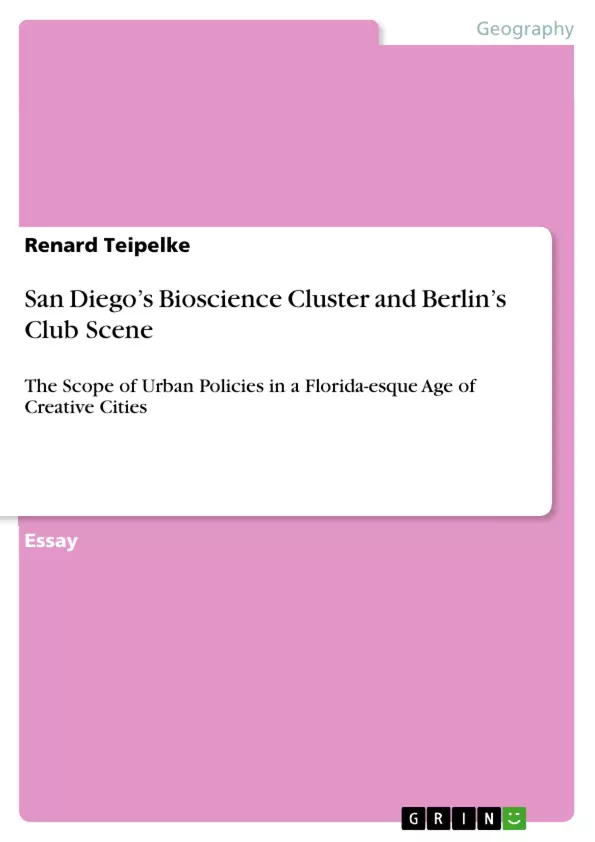This paper discusses the relation of Richard Florida’s notion of creative cities, cluster economics, and urban policies towards creative industries. Two empirical cases, San Diego’s bioscience cluster and Berlin’s club scene, are examined in order to reconstruct their success, analyze corresponding factors, identify challenges and problems, and discuss recent developments. Conclusions will be drawn on what city governments’ policies can or cannot as well as should not do to support creative industries. It will be argued that the scope of urban policies even in a Floridaesque age of creative cities is still wellrelated to (‘traditional’) cluster policies but therefore also limited by scale and dependent on private enterprises and cluster actors that have an active role in attracting other creative people.
Inhaltsverzeichnis (Table of Contents)
- Introductory Remarks
- Setting the Stage
- Refuting Florida, Praising Governance, Sidelining Cluster Economics
- Paper Outline
- Empirical Cases
- San Diego's Bioscience Cluster
- Berlin's Club Scene
- The Scope of Urban Policies
- Beyond the Scope of Urban Policies
- What City Governments Can Do
- Where City Governments Should Be Cautious
- Concluding Remarks
Zielsetzung und Themenschwerpunkte (Objectives and Key Themes)
This paper examines the relationship between Richard Florida's concept of creative cities, cluster economics, and urban policies towards creative industries. Two empirical cases, San Diego's bioscience cluster and Berlin's club scene, are analyzed to understand their success, identify challenges and problems, and discuss recent developments. The paper aims to draw conclusions about what city governments can and cannot do to support creative industries. The key themes explored are:- The relevance of Florida's creative city theory and its limitations.
- The role of governance in supporting creative industries.
- The significance of cluster economics in understanding creative industries.
- The limitations of urban policies in influencing creative industries.
- The importance of private enterprise and cluster actors in attracting creative talent.
Zusammenfassung der Kapitel (Chapter Summaries)
Introductory Remarks
This chapter introduces the concept of creative cities and highlights the debate surrounding Richard Florida's theory. The chapter discusses the limitations of Florida's approach and emphasizes the importance of governance, cluster economics, and the role of private enterprises in supporting creative industries.Empirical Cases
This section presents two case studies: San Diego's bioscience cluster and Berlin's club scene. It describes the success of these creative industries and discusses the factors that have contributed to their growth.The Scope of Urban Policies
This section examines the limitations of urban policies in influencing creative industries. It discusses how city governments can and cannot support these industries and stresses the need for a cautious approach.Schlüsselwörter (Keywords)
The key focus of this paper lies in examining the relationship between creative cities, cluster economics, and urban policies. It explores the role of governance in supporting creative industries and identifies the limitations of government intervention in this field. The paper also emphasizes the importance of private enterprises and cluster actors in attracting creative talent. Key terms include: creative cities, cluster economics, urban policies, governance, creative industries, talent, technology, tolerance, bioscience cluster, club scene, San Diego, Berlin.- Quote paper
- B.A. Renard Teipelke (Author), 2012, San Diego’s Bioscience Cluster and Berlin’s Club Scene, Munich, GRIN Verlag, https://www.grin.com/document/230180



